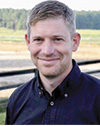There was a time on the farm when producers were really concerned about an upcoming calving season. Buying bulls prior to the era of expected progeny differences (EPDs) was a real guessing game. Now we have access to multiple genetic tools. Calving season for some will begin at the end of the month.
As producers prepare for fall calving by gathering all the equipment for calf processing and calving assistance, it can be a good time to evaluate the tools available for mating decisions and what they really mean.
Birthweight EPDs (BW) have been the “go to” for many bull buyers. Ag folks understand pounds. It readily makes sense in our minds to pick lower BW and lower BW EPD bulls in hopes of fewer calving problems. The animal breeders who develop and fine-tune EPDs teach us BW is an indirect measure of calving ease.
Which means, although there is a high correlation between birthweight and a calving score, weight is not the only part of the equation.
The shape of the calf is also important. Seedstock breeders turn in calving ease scores to their breed association. This is often a numerical scale, where a calf born with no assistance is reported as a “1” on a 1-to-5 scale. Some calving assistance receives a score of 2. This additional data, along with BW data, is where the calving ease direct EPD is derived.
Calving ease direct is a more direct predictor of unassisted births. A higher calving ease direct is an indicator of greater calving ease in first-calf heifers. Nutritional management and weather also plays a significant role. Heifers need to be in a body condition score of 6 at calving – not too fat and not too thin.
Producers are often surprised at how small their calves are at birth. True “calving ease bulls” are intended for use on heifers only. Live calves are the priority, but mature cows are at a much lower risk for calving difficulty compared to heifers.
Calves can be too big, and they can be too small. As we know, calves born too early or too light can have issues. As with numerous traits, we can swing the pendulum too far. We’ve only scratched the surface of this topic. Until next month. ![]()

-
Jason Duggin
- Beef Extension Specialist
- University of Georgia
- Email Jason Duggin







